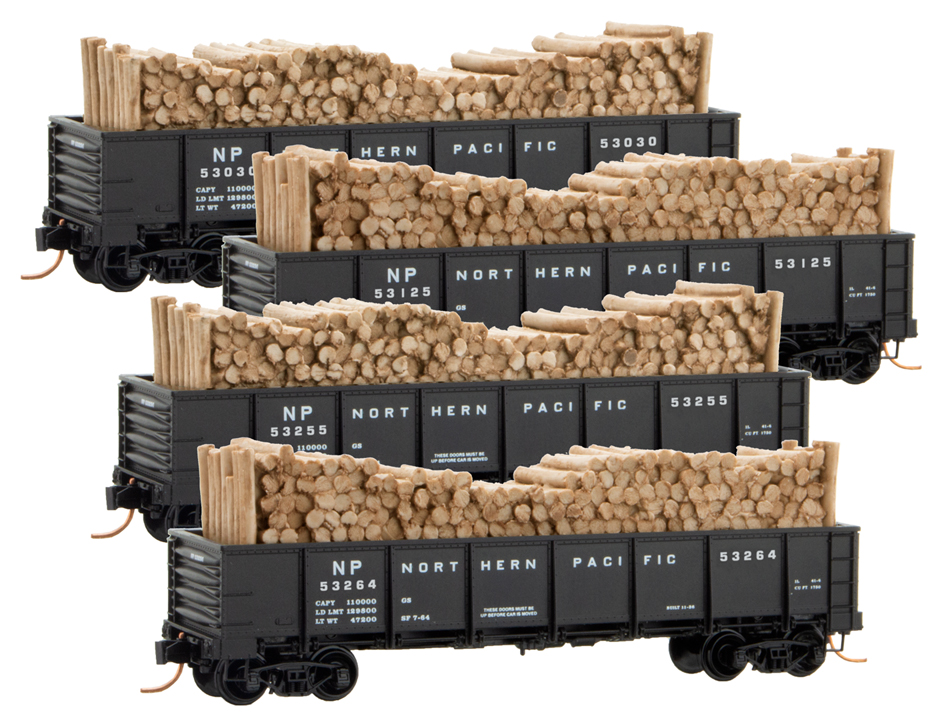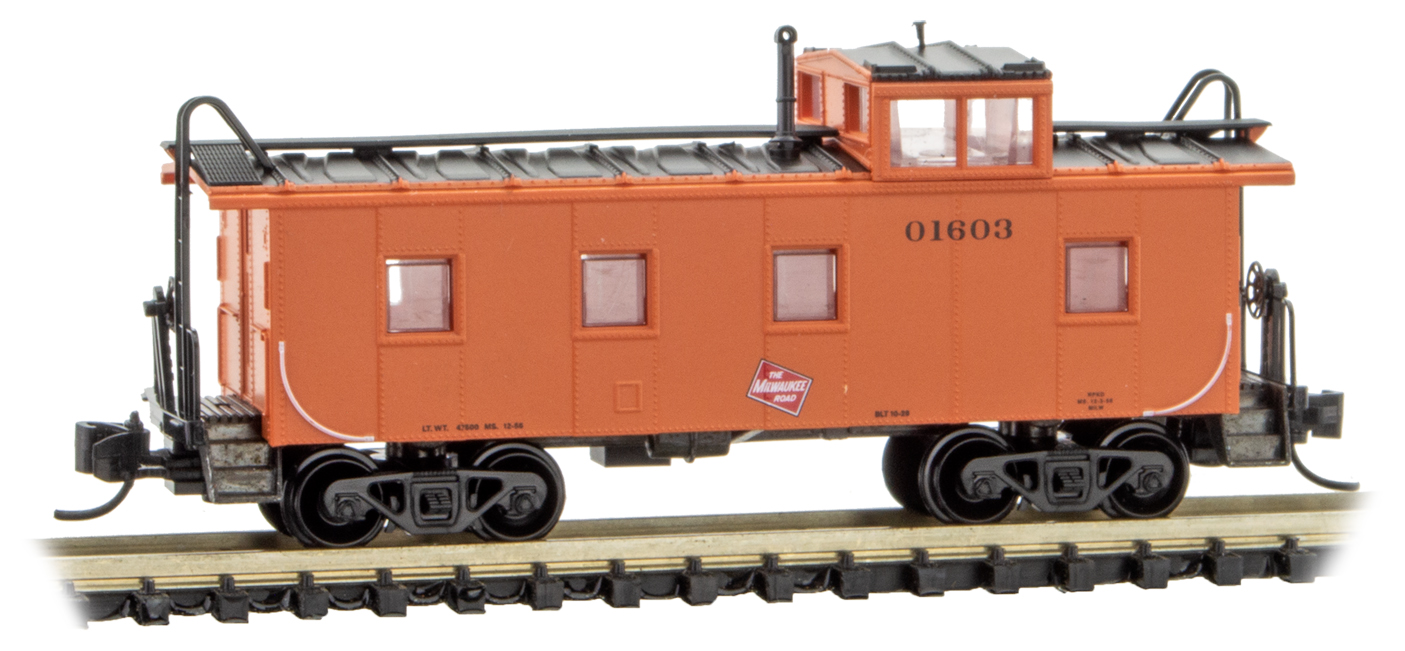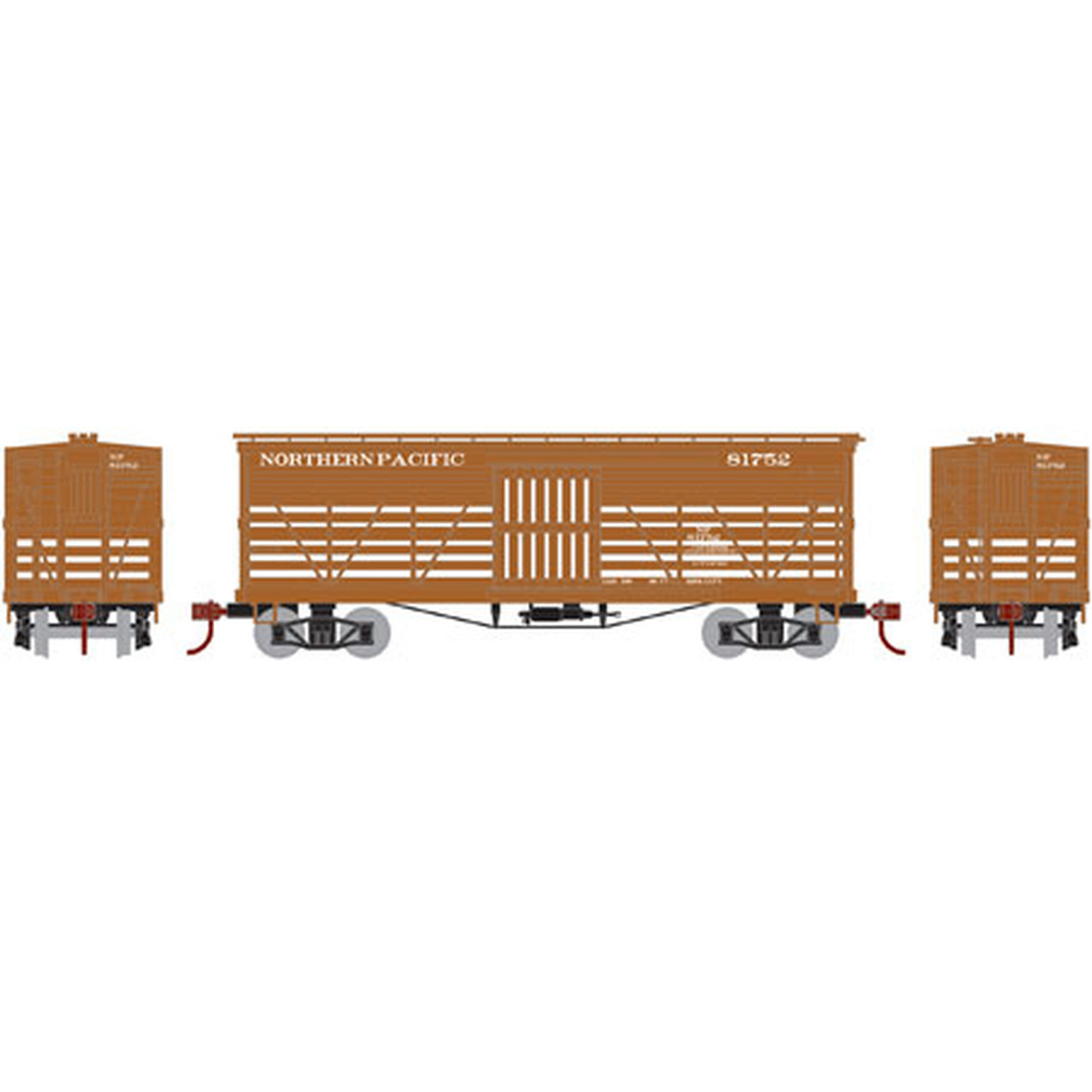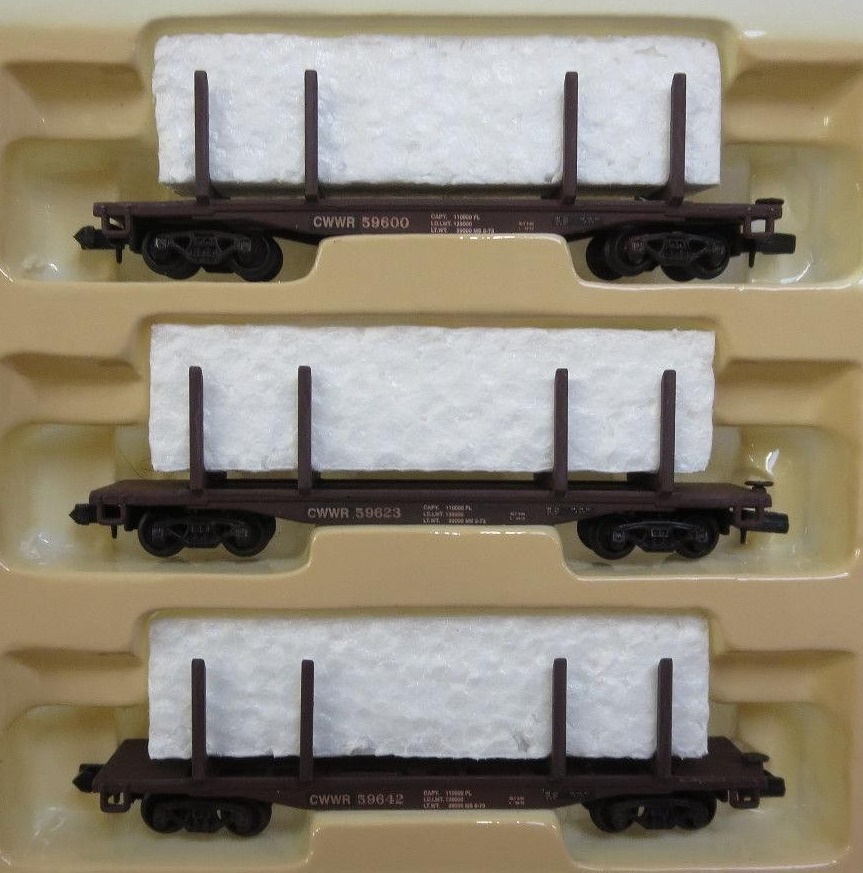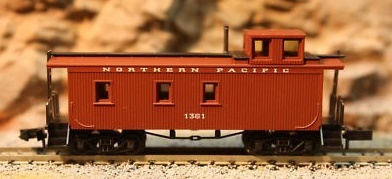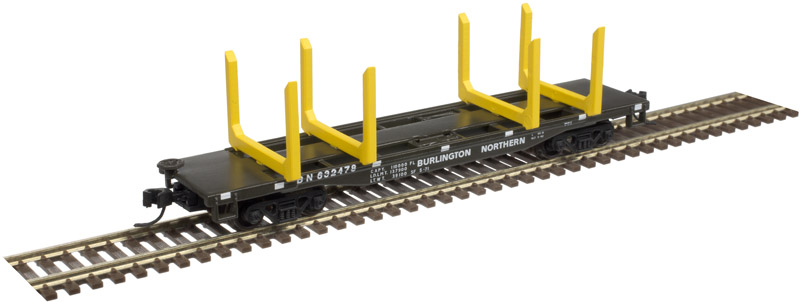Specific Item Information: Northern Pacific 4-Car Runner Pack
40' Drop Bottom Gondola w/ pulpwood load
Road Numbers 53030, 53125, 53255, 53264.
Prototype History: In US railroad terminology, a gondola is an open-topped rail vehicle used for transporting loose bulk materials. All-steel gondolas date back to the early part of the 20th century. Because of their low side walls gondolas are also suitable for the carriage of such high-density cargoes as steel plates or coils, or of bulky items such as prefabricated sections of rail track.
Drop-bottom gondolas were equipped with dump doors that operated via a mechanism located in the center of the car body. The drop bottom door provided a time-saving unloading method compared to the usual, labor-intensive procedure. Instead of equipping workmen with shovels to muck out the car’s content, the lever system was used to open the doors thus immediately dumping the load on the ground. Various commodities could be carried in the drop bottom gons, but coal loadings were most common. Many coaling towers had elevated trestle style delivery ramps where the drop bottom gondolas would be spotted and workmen could simply open the dump doors to spill the contents into the coal bins. At facilities with the elevator bucket style of coal dock, a ramp was used that led up to an open grate where the coal would spill through and into the lower coal bins. The gons were “tailor made” for company service such as dumping ballast directly onto track roadbed during maintenance, as well as hauling cinders out of various engine service facilities. Handy they were!
Drop-bottom gondolas were equipped with dump doors that operated via a mechanism located in the center of the car body. The drop bottom door provided a time-saving unloading method compared to the usual, labor-intensive procedure. Instead of equipping workmen with shovels to muck out the car’s content, the lever system was used to open the doors thus immediately dumping the load on the ground. Various commodities could be carried in the drop bottom gons, but coal loadings were most common. Many coaling towers had elevated trestle style delivery ramps where the drop bottom gondolas would be spotted and workmen could simply open the dump doors to spill the contents into the coal bins. At facilities with the elevator bucket style of coal dock, a ramp was used that led up to an open grate where the coal would spill through and into the lower coal bins. The gons were “tailor made” for company service such as dumping ballast directly onto track roadbed during maintenance, as well as hauling cinders out of various engine service facilities. Handy they were!
Road Name History:  The Northern Pacific Railway (reporting mark NP) was a transcontinental railroad that operated across the northern tier of the western United States from Minnesota to the Pacific Coast. It was approved by Congress in 1864 and given nearly 40 million acres (160,000 km2) of land grants, which it used to raise money in Europe for construction. Construction began in 1870 and the main line opened all the way from the Great Lakes to the Pacific when former president Ulysses S. Grant drove in the final "golden spike" in western Montana on Sept. 8, 1883.
The Northern Pacific Railway (reporting mark NP) was a transcontinental railroad that operated across the northern tier of the western United States from Minnesota to the Pacific Coast. It was approved by Congress in 1864 and given nearly 40 million acres (160,000 km2) of land grants, which it used to raise money in Europe for construction. Construction began in 1870 and the main line opened all the way from the Great Lakes to the Pacific when former president Ulysses S. Grant drove in the final "golden spike" in western Montana on Sept. 8, 1883.
The railroad had about 6800 miles of track and served a large area, including extensive trackage in the states of Idaho, Minnesota, Montana, North Dakota, Oregon, Washington and Wisconsin. In addition the company had an international branch to Winnipeg, Manitoba, Canada. The main activities were shipping wheat and other farm products, cattle, timber and minerals; bringing in consumer goods, transporting passengers; and selling land.
The company was headquartered first in Brainerd, Minnesota, then in Saint Paul, Minnesota. It had a tumultuous financial history, and in 1970 it merged with other lines to form the Burlington Northern Railroad.
Read more on Wikipedia.

The railroad had about 6800 miles of track and served a large area, including extensive trackage in the states of Idaho, Minnesota, Montana, North Dakota, Oregon, Washington and Wisconsin. In addition the company had an international branch to Winnipeg, Manitoba, Canada. The main activities were shipping wheat and other farm products, cattle, timber and minerals; bringing in consumer goods, transporting passengers; and selling land.
The company was headquartered first in Brainerd, Minnesota, then in Saint Paul, Minnesota. It had a tumultuous financial history, and in 1970 it merged with other lines to form the Burlington Northern Railroad.
Read more on Wikipedia.
Brand/Importer Information: Micro-Trains is the brand name used by both Kadee Quality Products and Micro-Trains Line. For a history of the relationship between the brand and the two companies, please consult our Micro-Trains Collector's Guide.
Manufacturer Information:  Micro-Trains Line split off from Kadee Quality Products in 1990. Kadee Quality Products originally got involved in N-Scale by producing a scaled-down version of their successful HO Magne-Matic knuckle coupler system. This coupler was superior to the ubiquitous 'Rapido' style coupler due to two primary factors: superior realistic appearance and the ability to automatically uncouple when stopped over a magnet embedded in a section of track. The success of these couplers in N-Scale quickly translated to the production of trucks, wheels and in 1972 a release of ready-to-run box cars.
Micro-Trains Line split off from Kadee Quality Products in 1990. Kadee Quality Products originally got involved in N-Scale by producing a scaled-down version of their successful HO Magne-Matic knuckle coupler system. This coupler was superior to the ubiquitous 'Rapido' style coupler due to two primary factors: superior realistic appearance and the ability to automatically uncouple when stopped over a magnet embedded in a section of track. The success of these couplers in N-Scale quickly translated to the production of trucks, wheels and in 1972 a release of ready-to-run box cars.
Micro-Trains Line Co. split off from Kadee in 1990 to form a completely independent company. For this reason, products from this company can appear with labels from both enterprises. Due to the nature of production idiosyncrasies and various random factors, the rolling stock from Micro-Trains can have all sorts of interesting variations in both their packaging as well as the products themselves. When acquiring an MTL product it is very important to understand these important production variations that can greatly enhance (or decrease) the value of your purchase.
Please consult our Micro-Trains Collector's Guide

Micro-Trains Line Co. split off from Kadee in 1990 to form a completely independent company. For this reason, products from this company can appear with labels from both enterprises. Due to the nature of production idiosyncrasies and various random factors, the rolling stock from Micro-Trains can have all sorts of interesting variations in both their packaging as well as the products themselves. When acquiring an MTL product it is very important to understand these important production variations that can greatly enhance (or decrease) the value of your purchase.
Please consult our Micro-Trains Collector's Guide
Item created by: gdm on 2019-02-01 18:37:58. Last edited by George on 2024-01-26 20:29:10
If you see errors or missing data in this entry, please feel free to log in and edit it. Anyone with a Gmail account can log in instantly.
If you see errors or missing data in this entry, please feel free to log in and edit it. Anyone with a Gmail account can log in instantly.


